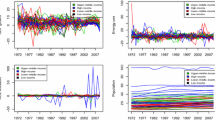Summary
The present paper deals with the study of continuous interval data by means of suitable Principal Component Analyses (PCA). Statistical units described by interval data can be assumed as special cases of Symbolic Objects (SO) (Diday, 1987). In Symbolic Data Analysis (SDA), these data are represented as hypercubes. In the present paper, we propose some extensions of the PCA with the aim of representing, in a space of reduced dimensions, images of such hypercubes, pointing out differences and similarities according to their structural features.








Similar content being viewed by others
References
Bock, H. H. and Diday, E. (eds): 2000, Analysis of Symbolic Data, Springer, (in press).
Cazes, P., Chouakria, A., Diday, E. and Schektman, Y.: 1997, Extension de l’analyse en composantes principales à des données de type intervalle, Revue de Statistique Appliquée XIV(3), 5–24.
Chouakria, A., Diday, E. and Cazes, P.: 1998, An improved factorial representation of symbolic objects, KESDA’98 27–28 April, Luxembourg.
D’Ambra, L. and Lauro, C. N.: 1982, Analisi in componenti principali in rapporto a un sottospazio di riferimento, Rivista di Statistica Applicata 15(1), 51–67.
De Carvalho, F. A. T.: 1992, Méthodes Descriptives en Analyse de Données Symboliques, Thése de doctorat., Université Paris Dauphine, Paris.
De Carvalho, F. A. T.: 1997, Clustering of constrained symbolic objects based on dissimilarity functions, Indo-French Workshop on Symbolic Data Analysis and its Applications, University of Paris IX.
Diday, E.: 1987, Introduction á l’approche symbolique en analyse des données, Journées Symbolique-Numerique, Université Paris Dauphine.
Diday, E.: 1996, Une introduction á l’analyse des données symboliques, SFC, Vannes, France.
Escofier, B. and Pagés, J.: 1988, Analyse factorielles multiples, Dunod, Paris.
Gettler-Summa, M.: 1997, Symbolic marking application on car accident reports, Applied Stocastic Models and Data Analysis, Vol. Invited and Specialised Session Papers, ASMDA, Anacapri, pp. 299–306.
Ichino, M.: 1988, General metrics for mixed features — the cartesian space theory for pattern recognition, International Conference on Systems, Man and Cybernetics.
Lauro, C. and Palumbo, F.: 1998, New approaches to principal components analysis to interval data, International Seminar on New Techniques & Technologies for Statistics, NTTS’98, 4/6 nov. 1998, Sorrento, Italy.
Lebart, L., Morineau, A. and Piron, M.: 1995, Statistique exploratorie multidimensionelle, Dunod, Paris.
Meccariello, G.: 1999, Analisi in componenti principali per dati ad intervallo, Tesi di Laurea in Statistica Universitá di Napoli “Federico II”.
Verde, R. and De Angelis, P.: 1997, Symbolic objects recognition on a factorial plan, NGUS’97, Bilbao Spain.
Acknowledgements
This paper has been developed in the ISO-3D Esprit project at DMS of University of Naples “Federico II.”.@@The output in [§7] has been realised with the collaboration of Dr. G. Meccariello (1999).
Author information
Authors and Affiliations
Rights and permissions
About this article
Cite this article
Lauro, C.N., Palumbo, F. Principal component analysis of interval data: a symbolic data analysis approach. Computational Statistics 15, 73–87 (2000). https://doi.org/10.1007/s001800050038
Published:
Issue Date:
DOI: https://doi.org/10.1007/s001800050038




